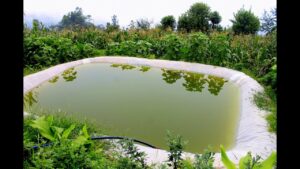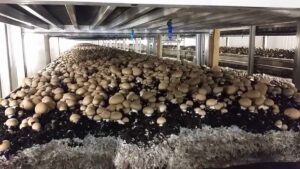Notable Elements
- Overview: Magic mushroom cultivation in Canada is gaining attention due to its potential benefits, but its environmental impact needs to be considered.
- Land Use: Magic mushrooms require less land compared to other crops, primarily because they are often grown indoors, leading to minimal challenges regarding deforestation or land degradation.
- Water Consumption: While magic mushrooms require less water than many traditional crops, it’s crucial to implement water conservation strategies.
- Waste Management: The cultivation produces organic waste, which, when managed responsibly, can be composted, promoting a closed-loop system and reducing landfill waste.
- Ecological Preservation: With mindful practices, magic mushroom cultivation can contribute to biodiversity and ecological sustainability, though potential threats like invasive species must be managed.
- Indoor vs. Outdoor Cultivation: The method of cultivation impacts the environmental footprint. Indoor cultivation is space-efficient but energy-intensive, while outdoor cultivation can lead to soil erosion and pest challenges.
- Biodiversity Concerns: Large-scale cultivation can disrupt local ecosystems; sustainable land use techniques are crucial to prevent negative impacts.
- Conservation Measures: Integrating mushroom cultivation with environmental conservation through practices like using organic materials, controlling invasive species, and efficient water systems can reduce the industry’s ecological footprint.
- Industry’s Responsibility: As the magic mushroom sector grows, it must prioritize sustainability by minimizing water usage, repurposing waste, and practicing sustainable land management.
- Consumer Role: Everyone involved, from consumers to growers, plays a part in promoting environmental awareness and pushing for sustainable mushroom cultivation practices.
Introduction
Magic mushroom cultivation commands considerable attention during this era of legalization of psychedelic substances. In the process, the benefits of magic mushrooms are discovered from medical to recreational purposes; however, how magic mushroom have affected the climate of Canada, and what are the implications for the environment? Let us see.
Factors Influencing Canada’s Environment
Several variables influence the environmental impact of magic mushroom production. These include land use, water consumption, waste management, and ecological preservation efforts.
Land Usage
Starting with land use, the nature of magic mushrooms allows for a flexible farming setup. Unlike other plant-based crops, magic mushrooms require less land for cultivation. They are usually grown indoors or in controlled environments, facilitating maximum yield from minimal space. As such, they pose a minor challenge to Canada’s natural habitats or ecosystems due to deforestation or land degradation.
Water Consumption
Any agricultural endeavor requires water, and mushroom cultivation is no exception. Compared to livestock or many cash crops, shroom farming uses less water. It is because mushrooms are 90% water, and their growth medium—often a compost of organic materials—retains moisture well. Thus, the potential for over-exploitation of water resources is minimal.
Waste Management
For waste management, growing magic mushrooms generates organic waste that can be composted and returned to the soil, contributing to a closed-loop system. Nevertheless, the type and quantity of waste depend on the cultivation method. Some methods might involve waste products that are harder to process or dispose of sustainably.
Ecological Preservation
With proper regulation and monitoring, magic mushroom cultivation may contribute to biodiversity by limiting land use and reducing water consumption. For ecological sustainability, repercussions from improper waste management must be minimized.
Understanding these characteristics allows for the development of a road map for ecologically mindful magic mushrooms growing in Canada.
Indoor vs. Outdoor Cultivation
Mushrooms, including the psychedelic kind, can be cultivated indoors and outdoors. However, the method chosen can significantly influence the land area required and the ecological footprint.
Indoor cultivation typically has a lower land use footprint as sowed in a controlled environment. It is space-efficient and allows for year-round cultivation, regardless of the weather conditions. However, it demands high energy use for creating suitable temperature and lighting conditions, which can contribute to greenhouse gas emissions.
On the other hand, outdoor cultivation, often done on farm fields, can lead to higher land usage but has the benefit of using natural sun and rain, reducing energy use. However, open-field cultivation can lead to soil erosion, exposing the crop to pests and diseases.
How does it damage biodiversity, and what steps should be taken for improvement?
The excessive production of any single crop, including magic mushrooms, influences biodiversity. Large-scale farming can disrupt local ecosystems and lead to a loss of habitat for native species. Additionally, outdoor mushroom farming could introduce non-native mushroom species to local environments, potentially altering the local ecosystem.
Sustainable Land Usage
The practice of sustainable cultivation techniques is essential to mitigate the harmful effects on land use and biodiversity. These may include:
– Using organic compost and nutrient sources to maintain soil health
– Implementing crop rotation to prevent soil exhaustion
– Maintaining buffer zones around cultivation areas to protect local wildlife
To promote environmental sustainability, growers should understand and address the land use issues associated with magic mushroom cultivation. By considering these factors seriously, Canada’s magic mushroom industry can grow responsibly and thrive without compromising the health and diversity of our environment.
Water Consumption in Magic Mushroom Cultivation
Magic mushrooms thrive in humid conditions, which necessitates constant watering. The process begins with sterilization, where substrates are soaked and boiled in water.
Once the mushrooms sprout, they need a daily misting to maintain optimal moisture levels. This ongoing need for water adds up, especially on a large scale.

Water Conservation Strategies
Considering the environmental implications, it is crucial to implement water conservation strategies. These might include:
– Utilization of humidity control systems that recycle water
– Collecting and using rainwater for mushroom cultivation
– Applying precision irrigation systems to minimize water waste
– Implementing practices that enhance soil water retention
By leveraging such strategies, we can significantly reduce the water footprint of magic mushroom cultivation, leading to a more sustainable and environmentally conscious industry.
Waste Management in Magic Mushroom Cultivation
Magic mushroom cultivation, like any other agricultural activity, contributes to solid waste generation. But if managed responsibly, this waste is not a burden to the environment.
Organic Waste Generation
The main waste products from cultivating magic mushrooms include spent mycelium and substrate—organic materials like grain, straw, or wood chips—that serve as the food source for the fungi. This process generates a significant amount of organic waste that, if improperly disposed of, can have detrimental effects on the environment, including hastening soil erosion and polluting water bodies.
Composting and Recycling Solutions
However, these waste products have excellent potential for composting, as they are rich in beneficial microorganisms and essential nutrients. The spent substrate turns excellent compost, and the mycelium enriches the soil. By doing so, the mushroom farming industry can significantly reduce the amount of waste that goes into landfills.
Minimizing Environmental Impacts
The magic mushroom sector has an incredible opportunity to reduce its environmental footprint by embracing composting and other recycling solutions. There is also potential to develop more sustainable farming methods, like vertical farming, that minimize waste and optimize mushroom growth—leading to less environmental damage. As the sector grows, implementing such strategies will be crucial to balancing the industry’s expansion with the protection of Canada’s environmental health.
Ecological Preservation in Magic Mushroom Cultivation
In the search to comprehend the environmental consequences of magic mushroom production, ecological preservation arises as a major problem. How does the industry impact the natural ecosystems? And how can conservation and restoration measures be applied?
Also Read : Why Has Growing Magic Mushrooms At Home Suddenly Started To Boom?
Threats to Natural Ecosystems
Magic mushroom cultivation, especially on a large scale, can pose significant threats to natural ecosystems. It includes land degradation due to the clearing of natural vegetation and potential contamination from artificial growth enhancers. Further risks involve invasive species and the extraction of large volumes of water, which may disrupt the local water cycle and lead to water scarcity.
Conservation and Restoration Measures By Industries
Despite these potential harms, there are ways to mitigate the ecological impact. Conservation and restoration measures include:
– Using organic and biodegradable materials in mushroom cultivation
– Utilizing water-efficient irrigation systems
– Controlling the spread of invasive species by adhering to local regulations
Adopting such practices can help reduce the environmental footprint of the industry.

Integrating Mushroom Cultivation with Environmental Conservation
Furthermore, integrating mushroom cultivation with environmental conservation can be beneficial. By nurturing a close bond with nature and promoting sustainable practices, growers can protect their local ecosystems while producing a useful commodity. Sustainable mushroom cultivation can be a part of the solution to environmental conservation, demonstrating that industry growth and nature preservation are not mutually exclusive.
Since the magic mushroom business uses a lot of water and land, having the capacity to create waste, it needs to prioritize sustainability just like any other industry. Appropriate measures must mitigate their environmental footprint, including minimizing water usage, repurposing spent mushroom substrate, and utilizing sustainable land management practices.
Call to Action: Promoting Environmental Awareness and Responsibility
We all have a role to play in fostering responsible and sustainable growth in the magic mushroom industry. As consumers, growers, or stakeholders, let’s drive the conversation about environmental impact and push for transparency and sustainable practices.
If we all work together, we ensure exciting new sector flourishes environmentally friendly and sustainable. Let us make magic mushrooms truly magic for our world!

Hi! I’m Jacob Hawthorne, a passionate medical student dedicated to exploring the fascinating world of psychedelics, particularly magic mushrooms (commonly known as shrooms). With a deep interest in their therapeutic potential and profound effects on the human mind, I aim to provide accurate and evidence-based information about shrooms in the Canadian context.

